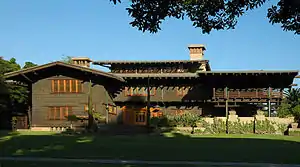Ultimate bungalow
An ultimate bungalow is a large and detailed Craftsman style home, based on the bungalow form. The style is associated with such California architects as Greene and Greene, Bernard Maybeck and Julia Morgan. Some of the hallmarks of Greene and Greene's ultimate bungalows include the use of tropical woods such as mahogany, ebony and teak, and use of inlays of wood, metal and mother-of-pearl. As in their other major projects, Charles and Henry Greene—and to a lesser extent Bernard Maybeck and a few other Craftsman-era architects who built such homes—sometimes designed the majority of furniture, textiles, fixtures and other interior details of these homes specifically for their location both in the house and in the larger landscape.

The term ultimate bungalow was popularized by its use as a chapter title in the 1977 book Greene & Greene, Architecture as a Fine Art by Randall Makinson.[1] The houses discussed in the chapter were the Greenes' Robert Blacker, David Gamble, Charles Pratt, Freeman Ford, William Thorsen, Earle C. Anthony, Dr. Crow, Willam Spinks, and William Lawless residences.
The ultimate bungalows include:
- Gamble House in Pasadena, California
- William R. Thorsen House in Berkeley, California
- Robert R. Blacker House in Pasadena, California
- Madison House in Pasadena, California (now headquarters of Pasadena Heritage)
- Charles M. Pratt House, also known as "Casa Barranca", in Ojai, California (built 1909)[2]
- John T. Greene Residence in Sacramento, California
See also
 Housing portal
Housing portal
References
- Greene & Greene (Pasadena, Calif.), & R. L. Makinson (1978). Greene and Greene: Architecture as a fine art. Salt Lake City u.a: Smith.
- Charles Millard Pratt House, USC Libraries Digital Collections